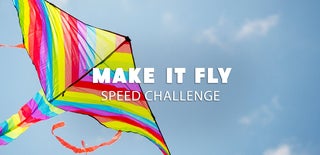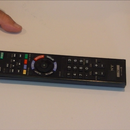Introduction: Flying Sign
The delta shaped flatplate airfoil has proven to be a stable flyer. The heart shape had been done so I looked around for another fun shape. The interstate highway signs were perfect!
Supplies
20 x 20”x ½” R-GARD foam board
16 ½” x 3/16” x 5/16” spruce (pico stick)
Foam trays 12” 1/16” wire
6” piece velcro
2 micro servos ( GWS pico, HS-55)
Micro receiver
( GWR-4PH) 2 amp Speed control
( GWS ICS50) GWS IPS “A” motor with 9 x 7 prop
Landing gear and wheels from Pico Stick 2” x ½”
1/64 plywood for control horns
Step 1: Template
I went to the Internet and in a short time I found a GIF of Delaware State Hwy 95 sign. A few minutes with PhotoShop, I had the California hwy 5 sign. I then eliminated the colors and used the “find contours” function to get an outline. This was then pasted into my CAD program to scale it to the right size and tile print it on a dozen sheets of paper. These were taped together to provide the stencil for the sign.
The white side could be used for the white lettering if a reverse stencil was used. This involves covering all the areas you want to be white.
Using a razor blade, I trace cut all the lines without pulling out the cut pieces. Little filaments of paper held them in place if they were not disturbed. Then the entire stencil was sprayed with adhesive and placed on the foamboard. The area to be painted blue was removed followed by a couple coats of spray enamel. The foam is safe because R-GARD has a plastic vapor barrier laminated to both sides. This also gives the foam the great strength. After blue paint has dried a bit, I masked off the blue by taping to the white (unpainted) strip that divides the blue from red. The red area stencil is removed and painted. The white lettering and outline are then removed.
Step 2: Leading Edge
The leading edge is then rounded by making ½ inch cuts top and bottom along the leading edge. The cuts are angled in to form a “V”. The edges are then pinched together and taped. This method works much better than beveling the edge.
Step 3: Equipment and Fins
The elevons are sliced away and beveled. Thin Mylar tape is the hinge from the top. Control rods are1/16 wire with “Z” bends at the attachments. The 3/16 x 5/16 spruce fuselage stick keeps the “airfoil” from bending. It is recessed in to the foam, glued and covered with tape. All of the radio gear is recessed into the foam and covered with Mylar tape. The control horns are cut from 1/64” plywood and glued into place. My favorite glue to use is of the polyurethane variety. It does take several hours to cure but it will not harm the foam and expands into it. The expansion will leave the glued joint unless it is sealed. I often cover with tape and a weighted paint stick.
The fins are attached to the “body” of the plane and extend past the hinge point. The extension makes them more effective. The fins are on the bottom to keep the top “clean”. They actually are more effective on the bottom as they are not blanked by high angle of attack of the “body”. Three were chosen over one due to the need to maintain some incidence if I want to take off from the ground. I could have used longer landing gear, but that would be ungainly, heavier and not premade. (they are from a Pico Stick) The three subfins equal the area of one bigger fin. (look kinda cool too!) The leading edge of the center fin is a 1/6” wire landing skeg pushed into the spruce fuselage. Each fin is glued with foam safe glue and supported by piercing the fin with a pin into the “body” Each fin is made from the foam you get from a foam food tray.
Velcro holds the battery in place and allows CG adjustment.
The CG in Deltas and flying wings is critical.
The landing gear holder (from a Pico stick) is pushed on the spruce stick followed by the GWS IPS motor. It flies well on a standard IPS “A” motor with a 9 x 7 prop. For more fun try the new dual motors with a bigger prop. I Homebrewed a dual “A” motor and used a 10 x 8 prop. The plane prop hangs using two QUALCOMM lithium ion cells.
I have also used 6 cell 270 mah, NiCads, 7 cell 300 mah NiHd, and 8 cell 370 mah NiHd with good results.
Step 4: Flying
Check your CG with a few test glides. Take off using full throttle being careful not to hang on the prop too much. Light aircraft can fool you when you have so much relative power. Once you are comfortable with the plane you can take off vertically from your hand. You are flying a symmetrical airfoil that will go were you put it. It flies just as well upside down as right side up. The undertuck is very predictable and easy to avoid if your CG is set right. I have 1 ½” of throw in the elevons in both directions. You do not need that much for normal flying but comes in really handy for slow and aerobatic flight.
I thought that the subfins would cause orientation problems, but this was not the case.
It is really a blast to fly and handles the wind really well. You will enjoy long stretches of inverted flight to enjoy the artwork. Outside loops are not common to parkflyers and really surprise the onlookers.
The plane is really durable so don’t let me catch you flying it like an old lady!
Step 5: Try Different Shapes
Many different shapes can be used

Participated in the
Make It Fly Speed Challenge











